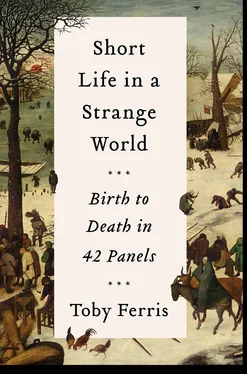‘… the boy a frolic courage caught To fly at random …’
Arthur Golding, translating Ovid
I once saw a young man fall from the sky.
I barely knew him. Dan was perhaps twenty, on leave from the army. My girlfriend’s sister, Zabdi, worked as a paragliding instructor on the Isle of Arran, and Dan was a friend of her boyfriend, Chris. And so there we were on a September morning in the late 1990s, Dan and Chris and my girlfriend Anna and Zabdi and I, on the slopes of a green hill on the Isle of Arran, paragliding.
When we picked him up in the minibus, Dan, already a qualified and experienced paraglider, was watching a video of stunt paragliders performing wild manoeuvres, swinging energetically beneath their canopies in figures of eight, looping the loop, skirting crags, skimming lakes, and Dan was clearly inspired. Later, on the mountain, as I was harnessed up and ready to bumble into the air, Zabdi put her hand on my chest and told me to wait: Dan had taken off higher up and was coming overhead. We watched him glide over us for a few seconds, and then, at an altitude of a couple of hundred feet, he started to swing beneath his canopy much as we had seen them do on the video, back and forth, like a pendulum, higher and higher, six, eight swings sweeping out an ever-lengthening arc, just enough time for Zabdi to mutter something under her breath ( for fuck’s sake, Dan ). Sure enough, he got up too far above his canopy and dropped into it, and in the skip of a heartbeat was tumbling uncontrollably earthward. We watched him fall, lost in his billowing parachute silks, then part emerging, arms thrown out, wheeling, tumbling, and then, thud, into the hillside. As I recall it, the hillside shook, but perhaps it didn’t; perhaps it was just an interior thud I felt. I remember Zabdi screaming ‘Dan’ and belting down the hillside towards where he lay, invisible in the deep gorse. I unharnessed myself and ran after her. There he was, stretched out on his back, laughing uncontrollably. His canopy, we reasoned later, must have caught a little air just as he landed and broken his fall. And then there was that cushion of gorse. Lucky boy.
The helicopter, a red-and-grey Sea King, had to lollop over from the mainland, nevertheless, and airlift him to Glasgow. He was in traction for six weeks, broken bones and compressed vertebrae. He hated the army, didn’t want to go back, and was never happier, they told me, than when he was lying there, immobilized, contemplating his mad descent.
A couple of years later he went missing in Dundee after a night’s drinking and was believed murdered, or drowned, until they found his body in a disused factory. He had been climbing on the roof, and it had given way.
*
In 2012, at the age of forty-two, I decided that I would travel to see the forty-two or so extant paintings by Pieter Bruegel the Elder. A mania for Bruegel had recently gripped me, and I had been thinking about little else. And then in early May of that year I realized that all of the paintings (except one) hung in public, or publicly viewable, collections. All were reachable. I suddenly saw that there was a great Bruegel Object out there, dismembered like the body of Osiris and strewn around the museums of Europe and North America, and I set myself to reconstitute it. I drew up a spreadsheet on which I recorded where the constituent limbs and parts of this prostrate god were located, and started to plan my journeys.
The Landscape with the Fall of Icarus , while it is on my spreadsheet, has been downgraded to a section devoted to probable copies, misattributions and mislabellings. Icarus is not one of the forty-two, is not authentic Bruegel but most likely a copy. It is unsigned and undated. It is painted on canvas. Most spreadsheet Bruegels are on wood panel, and can be dendrochronologically confirmed, and those that are on canvas are not in oil but in tempera. Radiocarbon dating of the Icarus is inconclusive – there are ambiguities in the calibration curve, thick layers of oxidized varnish which mask colours and throw off precision – but the samples of the oldest canvas harvested suggest a date from the end of the sixteenth century or the beginning of the seventeenth, thirty years after Bruegel died.
In January 2011, however, this doesn’t much matter: the spreadsheet is a year off, and the Icarus is the reason I am in the Bruegel room. I am drawn by its fame. W. H. Auden wrote a poem about it. So did William Carlos Williams. Everyone has seen it, in reproduction if not in fact.
I am in Brussels waiting for a friend whose flight is delayed; we are supposed to be on our way to Bruges, but I have a few loose hours to fill. I leave my bags at the station and walk up into the centre of the city, and locate what Auden called the Musée des Beaux Arts.
Museums are safe havens. International space. No one looks twice at you in a museum. No one expects you to speak French, for example, as they might elsewhere in Brussels, in the real city. So I have a cappuccino and a croissant, and I automatically belong. I start to breathe easy.
The museum is extensive, however, and, my coffee done, I get a little lost wandering in the modern wings. It turns out there is such a thing as nineteenth-century Belgian art. And a big thing it is. But eventually I clamber up to the upper galleries where they have constructed a chronological circuit from Van der Weyden to Rembrandt and Rubens, more or less. I pick a door at hazard: it is the wrong door, and I make my progress clockwise, back through history. I freefall past Rembrandts and Van Dycks and other brown paintings, start to meet some shuddering resistance around the end of the sixteenth century, and I am still some distance away from the fifteenth-century Flems where I expect softly to touch down and walk with the strange beasts in Eden, when I happen into the corner room of Bruegels.
Here is Icarus . My idle descent through the gallery may have come to an abrupt halt, but my life has just accelerated without my realizing it. I have entered the slipstream of an as yet invisible project, a dark mass lying in the future. If I could look down on myself, see myself situated in all the meaningful relations of my life, my hair would be streaming, my cheeks juddering, in the chill jets of air.
Gravity is a weak but insistent force. Perhaps not a force at all, but a geometry. Who knows where its centres lie, or to what we are tending?
My notebooks of the time are sketchy on the subject of Bruegel. I see that I made a solitary note about the Icarus . That ploughman, I observed, was never going to be able to turn his horse and his plough at the bottom of that field.
It is not a profound observation. I have picked up on an oddity of composition – the narrow, constrained hundred, the clodhopping ploughman and his lean horse. But it leads, I see now, to others. The ploughman’s weight distribution is all wrong. The sheep, also, are ill-managed, crammed into a perilous corner of a field.
Clodhopping ploughman: Landscape with the Fall of Icarus , detail.
And the ship is wrongly rigged. Bruegel made a number of drawings of ships for a series of engravings in the early 1560s, caravels and sloops and brigantines and oceangoing three-masters, all accurately observed and set down, their complex unreadable rigging read anyway by a sharp eye. An adopted son of the great port of Antwerp, he would have had time to learn. Anyway, this Icarus ship is wrongly rigged or cack-handedly painted (the anamorphic hull would suggest the latter). Expensive delicate ship, Auden calls it. But those tiny seamen are furling all the wrong sails, leaving the lateen at the back, the absurd straining foresail caught in a squall or a hurricane – how is the ploughman’s cap not blown off, zipped up into some vortex of winds? – the billow of the sail at odds, seemingly, with the play of its cross-spar, the whole contraption flapping about chaotically. The shrouds on the foremast are wrongly positioned (or again, poorly painted). Much too much sail, in too narrow a space (although a second ship in the background is charging into port with a full spread of sail and an apparent death wish).
Читать дальше












